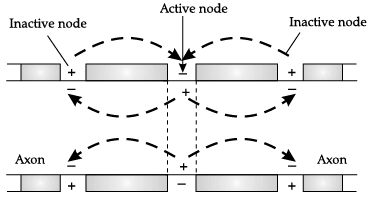Class 11 Biology: CBSE Sample Question Papers- Term II (2021-22)- 2 | Sample Papers for Class 11 Medical and Non-Medical - JEE PDF Download
| Table of contents |

|
| Class Xl |

|
| Time: 120 Minutes |

|
| Max. Marks: 35 |

|
| Section - A |

|
| Section - B |

|
| Section - C |

|
Class Xl
Time: 120 Minutes
Max. Marks: 35
General Instructions:
- All questions are compulsory.
- The question paper has three sections of 13 questions. All questions are compulsory.
- Section–A has 6 questions of 2 marks each; Section–B has 6 questions of 3 marks each; and Section–C has a case-based question of 5 marks.
- There is no overall choice. However, internal choices have been provided in some questions. A student has to attempt only one of the alternatives in such questions.
- Wherever necessary, neat and properly labelled diagrams should be drawn.
Section - A
Q.1. Two potted plants were kept in an oxygen free environment in transparent containers. Plant A was exposed to green light and Plant B to sunlight. Which one of the two, will show more photosynthesis and is likely to survive longer and why?
Plant B will show more photosynthesis. Chlorophyll absorbs maximum light in the blue region of the spectrum, i.e., 400–450 nm and hence photosynthetic rate will also be high. Plant A will show negligible amount of photosynthesis or no photosynthesis, as chlorophyll does not absorb any light in the green region, i.e., 500– 550 nm but reflects light.
Q.2. Different substrates get oxidized during respiration. How does Respiratory Quotient (R.Q.) indicate which type of substrate, i.e., carbohydrate, fat or protein is getting oxidized?
R.Q. = A/B
What do A and B stand for? What type of substrates have R.Q. of 1, < 1 or > 1?
In R.Q., A stands for CO2 released, while B stands for O2 being consumed by unit mass of a substrate. The ratio indicates the type of substrate being consumed in respiration.
Substance like carbohydrates have RQ = 1, during aerobic respiration.
Proteins and fats have R.Q. of < 1 and are found during germination of seeds.
Substrates like organic acids have R.Q. of > 1 under aerobic conditions.
OR
Energy is released during the oxidation of compounds in respiration. How is this energy stored and released as and when it is needed.
Energy is stored as bond energy of ATP. This bond is broken down to release energy when required.
ADP + Pi + Energy → ADP + Pi or ATP
ATP → ADP + Pi + Energy
Q.3. A plant hormone is a chemical substance produced naturally in plants which is translocated to another region for regulating one or more physiological reaction, when present in low concentration. In how many groups does plant growth regulators are classified?
Based on functions, plant growth regulators are broadly classified into two groups:
(i) Growth promoters: Such plant growth regulators are involved in growth promoting activities such as cell division, cell enlargement, pattern formation, etc. These include auxins, gibberellins and cytokinins.
(ii) Growth inhibitors: Such PGRs are involved in various growth inhibiting activities such as promotion of dormancy and abscission. These include abscisic acid and ethylene.
Q.4. Neurons are classified into two categories based upon the presence or absence of myelin sheath: Myelinated neurons and non- myelinated neurons.
(i) Why is the mode of conduction of electrical impulse along the myelinated neurons advantageous to a non-myelinated neuron?
(ii) What is this type of conduction called?
(i) This is so because the ionic changes and consequent depolarization takes place only at the nodes of Ranvier, which is free from myelin sheath leading to the jumping of action potential from one node to the next.
(ii) This type of conduction of impulse along a myelinated nerve fibre, is called saltatory conduction.
Q.5. Sohan was experiencing something abnormal during the urination process. He went to a doctor for a check-up, after which he came to know that his kidneys are damaged. Can you predict what is going to happen to him next?
The kidneys are considered as master chemists of the body.
(i) If they are damaged, it would disturb the normal functioning of his life processes.
(ii) Due to the effect of toxins produced by some bacteria, the filters of tiny uriniferous tubules also get damaged.
(iii) They become perforated with larger holes and allow blood cells, and proteins to pass through them along with the urea and water during filtration of blood in the formation of urine.
Q.6. George comes on a vacation to India from US. The long journey disturbs his biological system and he suffers from jet lag. What is the cause of his discomfort?
It is due to the disturbance in diurnal rhythm. Melatonin plays a very important role in the regulation of a 24-hour (diurnal) rhythm of our body. For example, it helps in maintaining the normal rhythms of sleep-wake cycle, body temperature and disturbance in this cycle causes discomfort.
OR

The given gland consists of four separate glands located on the posterior surface of the lobes of the thyroid gland, one pair each in the two lobes.
(i) Name its secretion. How is its secretion regulated?
(ii) Mention one parathyroid disorder.
(i) The parathyroid glands secrete parathyroid hormone or parathormone, the secretion of which is regulated by the circulating calcium ion.
(ii) Hypoparathyroidism causes the lowering of blood calcium level thereby leading to parathyroid tetany.
Section - B
Q.7. (i) Given below is the diagram showing ATP synthesis during aerobic respiration, replace the symbols A, B, C, D and E by appropriate terms given below:
F1 particle, Pi, 2H+, Inner mitochondrial membrane, ATP, F0 particle, ADP
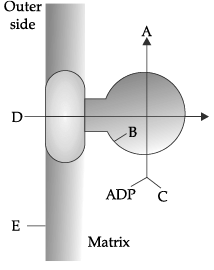
(ii) Define the term ETS.
(i)
- ATP
- F1 particle
- Pi
- 2H+
- Inner mitochondrial membrane
(ii) The metabolic pathway through which the electron passes from one carrier molecule to another is called Electron Transport System (ETS).
Q.8. Respiration is an energy releasing and enzymatically controlled catabolic process which involves a step-wise oxidative breakdown of organic substances inside living cells. With the help of this statement about respiration, explain the meaning of:
(i) Step-wise oxidative breakdown
(ii) Organic substances (used as substrates).
(i) Step wise oxidative breakdown means release of small amount of energy, so that same can be trapped and stored for later use. Respiration is a step-wise oxidation of organic molecules in a cell, which involves three main steps: Glycolysis, Krebs cycle and Electron Transport Chain.
(ii) Organic substrates are respiratory substrates which are oxidized during respiration to liberate energy inside the living cells. The common respiratory substrates are carbohydrates, proteins, fats and organic acids.
Q.9. The diagram given below represents a nephron and its blood supply.
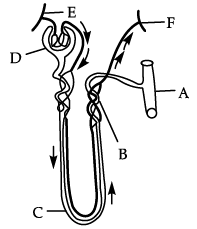
(i) Label parts A, B, C and D.
(ii) State the reason for the high hydrostatic pressure in the glomerulus.
(i) Different parts in the diagram are labelled as:
A – Collecting duct.
B – Distal convoluted tubule (DCT).
C – Loop of Henle.
D – Bowman’s capsule.(ii) As the afferent arteriole splits into many fine branches due to which the volume of capillaries reduce, thus raising the hydrostatic pressure in the glomerulus.
Q.10. (i) How is glomerular filtrate hypertonic and hypotonic in descending and ascending limb of loop of Henle respectively?
(ii) What is the effect of ADH on collecting tubules?
(i) Counter current system is found in two limbs of loop of Henle. The ascending limb transports Na+ and some urea into surrounding medullary tissue. It is impermeable to water. So, it makes urine dilute or hypotonic. The walls of descending limbs are permeable to water and salt, so Na+ and water from surrounding fluid are absorbed. Thus, the contents of urine become hypertonic.
(ii) ADH (Antidiuretic Hormone): ADH is secreted when the osmotic pressure of blood increases due to excess loss of water from the body. The hormone renders the walls of distal convoluted tubule (DCT), collecting tubule (CT) and collecting duct of a nephron permeable to water and increases the reabsorption of water into the surrounding tissues and particular capillaries. The urine becomes hyperosmotic and less in volume and water is conserved in the body.
Q.11. The given diagram represents the structure of a human brain.
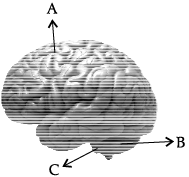
(i) Identify the label A, B and C.
(ii) What happens if medulla oblongata is damaged due to some accident?
(iii) State any one function of cerebellum.
(i) In the given structure of brain, the label A represents cerebrum, Label B is cerebellum, and label C is brain stem.
(ii) Medulla oblongata is a part of brain stem, derived from the hindbrain that is continuous with the spinal cord. Its function is a to regulate the reflex responses controlling respiration, heartbeat, blood pressure, and other involuntary processes. So, if medulla oblongata gets damaged, it can lead to respiratory failure, paralysis, or loss of sensation.
(iii) Cerebellum maintains equilibrium and posture.
Q.12. The given diagram represents the human respiratory system.
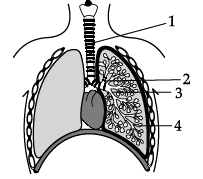
(i) Identify the labels 1, 2, 3 and 4 marked in the diagram.
(ii) Name the structure which prevents the collapsing of trachea.
(iii) Why gaseous exchange continues in the lungs even after expiration?
(i) In the given diagram, label 1, 2, 3 and 4 represents trachea, bronchi, bronchioles and alveoli respectively.
(ii) Cartilaginous rings are the C-shaped structure which prevents the collapsing of trachea.
(iii) Gaseous exchange continues in the lungs even after expiration because of the presence of residual volume.
Section - C
Q.13. Mitosis is the process of cell division in which one cell gives rise to two genetically identical daughter cells, resulting in cell duplication and reproduction. The major purpose of mitosis is for growth and to replace worn out cells., It is divided into four phases, namely, prophase, metaphase, anaphase and telophase.
(i) Why is mitosis an equational division?
(ii) What would be the consequences if each of the following irregularities occurs during mitosis?
- Nuclear membrane fails to disintegrate.
- Duplication of DNA does not occur.
- Centromeres do not divide.
- Cytokinesis does not occur.
(i) Mitosis is an equational division because the daughter cells have the same number of chromosomes and an equal amount of cytoplasm.
(ii)
- If nuclear membrane fails to disintegrate, the spindle fibers would not be able to reach chromosomes and they would not move towards opposite poles of the cell.
- If duplication of DNA does not occur, then the cell might not be able to surpass S phase of the cell cycle. Thus, the cell will not be able to enter M-phase or if in case it enters mitosis, the cycle will cease.
- If centromeres do not divide, then the daughter cell will receive a complete pair of chromosomes. This may result in trisomy.
- If cytokinesis does not occur, then it would not result in the formation of daughter cells.
OR
In a biology class, teacher explains the students, the different stages of cell cycle. She has drawn a diagram that explains the events taking place during cell cycle of a somatic cell.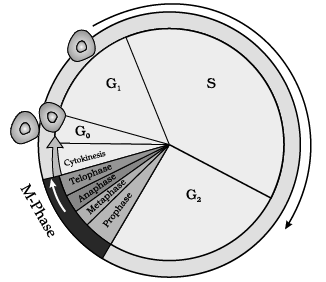
(i) What is G1 phase in the cell cycle?
(ii) What amount of DNA is present in the cell during the G2 phase?
(iii) How does cytokinesis differ in plant and animal cells?
(i) G1 phase:
- In this phase, the cell is metabolically active and continuously grows but does not replicate its DNA.
- RNA and proteins are synthesized and the cell grows in size.
(ii) Double the amount of DNA present in the original diploid cell.
(iii) Differences between cytokinesis in plant cells and animal cells:

